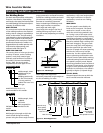
Wire Feed Arc Welder
8
Welding Guidelines (Continued)
Arc Welding Basics
Five basic techniques affect weld quality.
These are: wire selection, heat setting,
weld angle, wire speed, and travel speed.
An understanding of these techniques is
necessary for effective welds.
HEAT SETTING
The correct heat involves the adjustment
of the welding machine to the required
setting. Heat or voltage is regulated by a
switch on the welder. The heat setting
used depends on the size (diameter) and
type of wire, position of the weld, and
the thickness of the work piece. Consult
specifications listed on the welder. It is
suggested that the welder practice with
scrap metal to adjust settings, and
compare welds with Figure 15.
WIRE TYPE AND SIZE
The correct choice of wire type involves
a variety of factors, such as welding
position, work piece material type,
thickness, and condition of surface to
be welded. The American Welding
Society, AWS, has set up certain
requirements for each type of wire.
FLUX-CORED WIRE
E - 7
0 T
- GS
Weld strength, times
10,000 pounds per
square inch
Welding positions (0
for flat or horizontal,
1 for any position)
Tubular flux core wire
Flux type
AWS E71T-GS or E71T-11 is
recommended for this welder.
SOLID WIRE
ER - 70 S - 6
Weld strength, times
1,000 PSI
Solid wire
Wire composition
ER-70S6 is recommended for this
welder.
WELD ANGLE
Weld angle is the angle at which the
nozzle is held during the welding
process. Using the correct angle ensures
proper penetration and bead formation.
As different welding positions and weld
joints become necessary, nozzle angle
becomes an increasingly important
factor in obtaining a satisfactory weld.
Weld angle involves two positions -
travel angle and work angle.
Travel angle is the angle in the line of
welding and may vary from 5º to 45º
from the vertical, depending on welding
conditions.
Work angle is the angle from
horizontal, measured at right angles to
the line of welding. For most
applications, a 45º travel angle and 45º
work angle is sufficient. For specific
applications, consult an arc welding
handbook.
WIRE SPEED
The wire speed is controlled by the
knob on the front panel. The speed
needs to be “tuned” to the rate at
which the wire is being melted in the
arc. Tuning is one of the most critical
functions in wire feed welding. Tuning
should be performed on a scrap piece
of metal the same type and thickness as
that to be welded. Begin welding with
one hand “dragging” the gun nozzle
across the scrap piece while adjusting
the wire speed with the other hand.
Too slow of speed will cause sputtering
and the wire will burn up into the
contact tip. Too fast a speed will also
cause a sputtering sound and the wire
will push into the plate before melting.
A smooth buzzing sound indicates the
wire speed is properly tuned. Repeat
the tuning procedure each time there is
a change in heat setting, wire diameter
or type, or work piece material type or
thickness. For Aluminum, wire speed is
typically set higher (7-9 speed range).
TRAVEL SPEED
The travel speed is the rate at which the
torch is moved across the weld area.
TRAVEL ANGLE
WORK ANGLE
5º - 45º
5º - 45º
Figure 14 - Weld Angle
Normal Heat,
Wire Speed,
Travel Speed
Heat Too Low
Heat Too High
Wire Speed
Too Fast
Wire Speed Too Slow
Travel Speed
Too Slow
Travel Speed
Too Fast
Base
Metal
Figure 15 - Weld Appearance
www.chpower.com


















